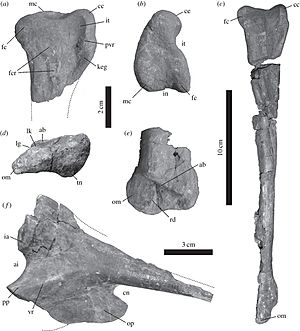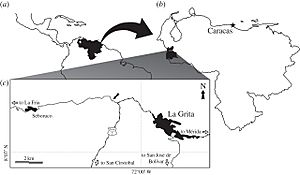Tachiraptor facts for kids
Quick facts for kids Tachiraptor |
|
|---|---|
 |
|
| IVIC-P-2687, the holotype right tibia, and IVIC-P-2868, the referred left ischium | |
| Scientific classification | |
| Genus: |
Tachiraptor
|
| Species: |
admirabilis
|
Tachiraptor (say "Tah-chee-RAP-tor") means "thief of Táchira". It was a meat-eating dinosaur that lived in the early Jurassic period. Scientists found its fossils in the La Quinta Formation in Venezuela.
This dinosaur is known from one species, Tachiraptor admirabilis. Its name comes from a fossilized shinbone (tibia) and a hip bone (ischium). Tachiraptor was a small dinosaur that walked on two legs. It was about 1.5 meters (5 feet) long. It probably hunted smaller animals like other dinosaurs or lizards.
Contents
Finding Tachiraptor Fossils

Since the late 1980s, dinosaur bones have been found in the state of Táchira, Venezuela. These fossils were uncovered near a road between La Grita and Seboruco. Most of the early finds belonged to a small plant-eating dinosaur called Laquintasaura.
But scientists also found some teeth from a meat-eating dinosaur. This showed that a predator must have lived there too. In 2013, more bones from a meat-eating dinosaur were found. This confirmed the idea.
In 2014, scientists named and described Tachiraptor admirabilis. The team included Max Cardoso Langer, Ascanio D. Rincón, Jahandar Ramezani, Andrés Solórzano, and Oliver Rauhut.
The description was based on two main fossils. They came from a rock layer in the La Quinta Formation. This layer dates back to the Early Jurassic period, specifically the Hettangian stage. At that time, this area was near the equator of the ancient supercontinent called Pangaea.
The two fossils were found in the same spot. Scientists believe they came from two different Tachiraptor individuals. One fossil, called IVIC-P-2867, is a nearly complete right shinbone. The other fossil, IVIC-P-2868, is the top part of a left hip bone. Scientists think this hip bone also belongs to Tachiraptor admirabilis. They believe only one type of meat-eating dinosaur of this size lived in the La Quinta Formation.
What Does the Name Tachiraptor Mean?
The name Tachiraptor comes from the state of Táchira in Venezuela. This is where the dinosaur was discovered. The second part of the name, raptor, is a Latin word meaning "thief".
The species name, admirabilis, means "admirable". It honors the Admirable Campaign of 1813. This was an important military campaign led by Simón Bolívar. The area where Tachiraptor was found, La Grita, was very important during that campaign.
How Tachiraptor Looked
Tachiraptor was a small dinosaur that walked on two legs. Its shinbone is about 25 centimeters (10 inches) long. From this, scientists guess that the whole animal was a little over 1.5 meters (5 feet) long.
Scientists found some special features on Tachiraptor's bones. One unique feature is on the top surface of its shinbone. This surface usually has two bumps or "projections" at the back. In Tachiraptor, the outer bump had a very sharp point. This point stuck out further back than the inner bump. This is a unique trait for Tachiraptor.
Other features, when put together, also make Tachiraptor special. For example, the bottom of its shinbone was about 1.5 times wider than it was long. Also, a ridge on the front of the shinbone, where the ankle bone (talus) would attach, ran at a slant. These details help scientists tell Tachiraptor apart from other dinosaurs.
Tachiraptor's Family Tree
Scientists use something called "cladistic analysis" to figure out how dinosaurs are related. This helps them draw an "evolutionary tree." This analysis showed that Tachiraptor was an early member of a group called Neotheropoda. This group includes almost all meat-eating dinosaurs, even birds.
Tachiraptor was placed low on the neotheropod family tree. It was part of the group that led to the Averostra. This group includes all theropods from the Middle Jurassic onwards. Because Tachiraptor was like a "sister species" to the Averostra, it's called a "stem-averostran."
Finding Tachiraptor was very important. Before 2014, scientists didn't have clear examples of these "stem-averostrans." Tachiraptor helped fill a gap in the fossil record. It showed that this group of dinosaurs existed 25 million years earlier than thought.
Tachiraptor also helped scientists learn more about how early dinosaurs developed. It confirmed that the area near the equator of the supercontinent Pangaea was important for their evolution. The discovery of Laquintasaura had already suggested this.
Where Tachiraptor Lived
Tachiraptor lived in what is now Colombia and Venezuela, in northern South America. Its fossils were found in the Venezuelan part of the La Quinta Formation.
The environment of the La Quinta Formation was likely a tropical lowland forest. This area's location and time suggest that large plant-eating dinosaurs called eusauropods spread widely before Pangaea broke apart.
Other dinosaurs found in this formation include the eusauropod Perijasaurus from Colombia. Also, the plant-eating ornithischian Laquintasaura was found in Venezuela.
See also
 In Spanish: Tachiraptor admirabilis para niños
In Spanish: Tachiraptor admirabilis para niños

